The Estidama Mosque, designed by X Architects as a community mosque in Masdar Park in Abu Dhabi, UAE is a remarkable milestone reflecting Masdar City’s commitment to environmental and cultural sustainability goals. This modest 500 square-meter project is notably the region’s first LEED Platinum-certified mosque achieving international standards of sustainability, with plans for a significantly larger second one in the future.
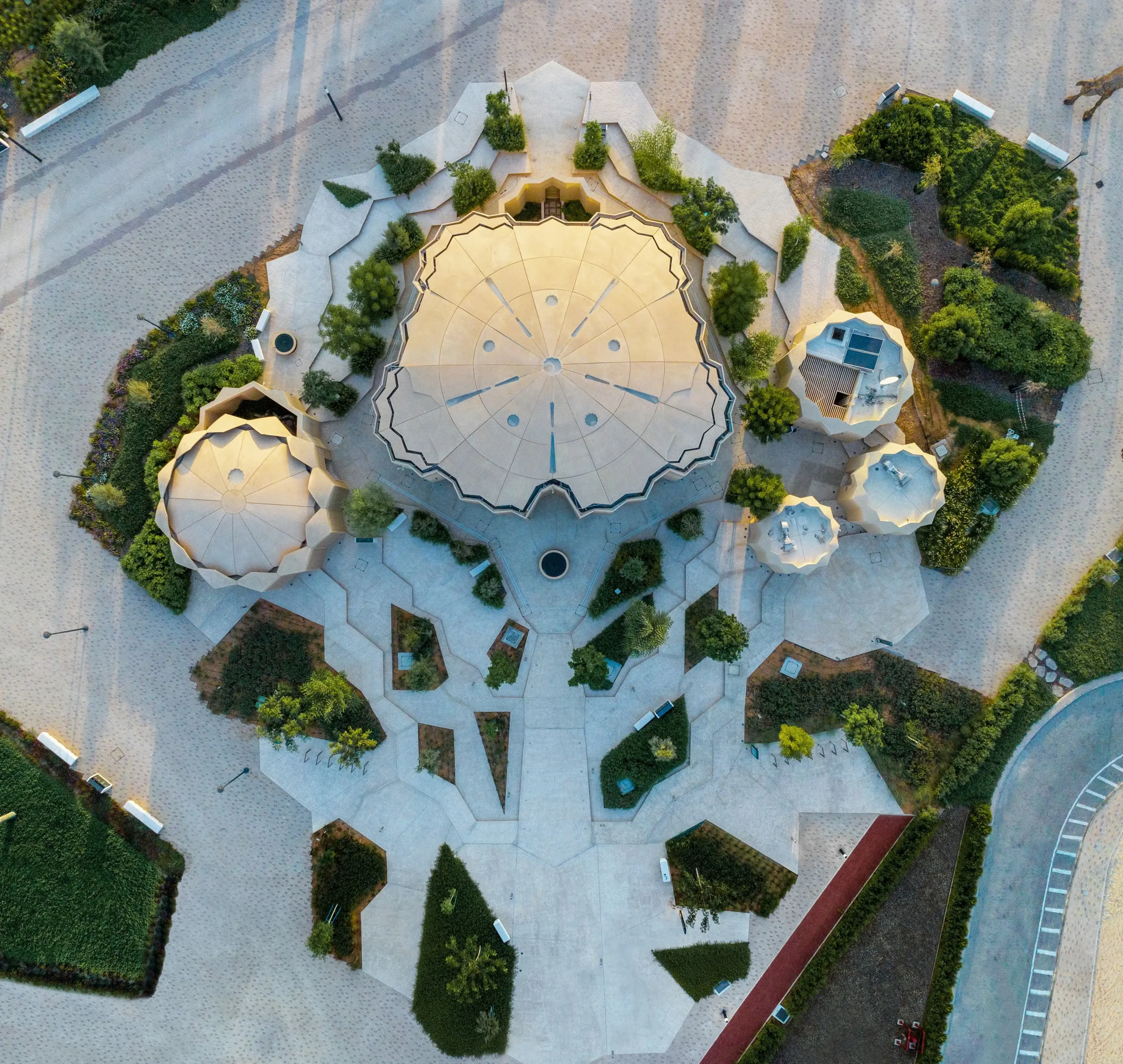
One of the distinguishing features of this mosque is its Paradise Garden, unifying the distinct components of the mosque and providing a spiritual experience. X Architects planned this landscape element of the mosque complex to function as a threshold connecting the people from Masdar Park to the main prayer hall. The Mosque’s Dome, though it appears to be meek from the exteriors due to its color, is a structurally sound piece with intricate patterns, an array of skylights, and differing roof thicknesses, which also alters the experience of interiors, elevating one’s spirit.
Conceptual Approach Driving the Mosque Design
The conceptual approach of this exemplary mosque design was rooted in Islamic traditions and principles whilst adopting sustainable solutions aligning with Masdar City’s goals and commitments. The mosque is designed as an abstraction of the traditional mosque components and features and a tangible establishment of the principles mentioned in the holy Quran, adopting sustainable passive design solutions.
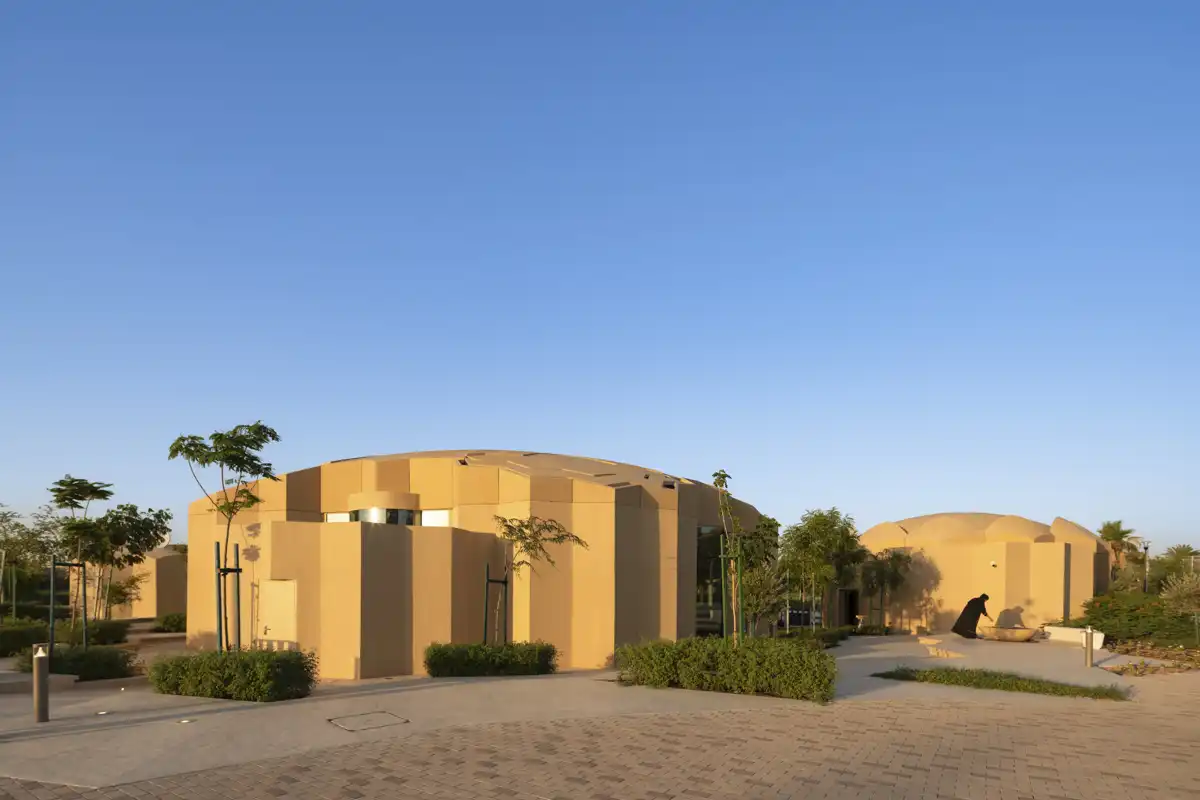
The mosque complex features a textured multifaceted landscape design accentuating the spiritual experience in the complex. The mosque’s landscape design features a rich stepped topography, including several plant species, water features, and hardscaping pavements.
This garden is home to various plants, including medicinal plants like turmeric, ginger, lentils, barley, wheat, mustard, and basil, in addition to trees like date palm and camphor trees, adding a vertical dimension and shading the pathways below, contributing to passive means of thermal comfort outdoors.
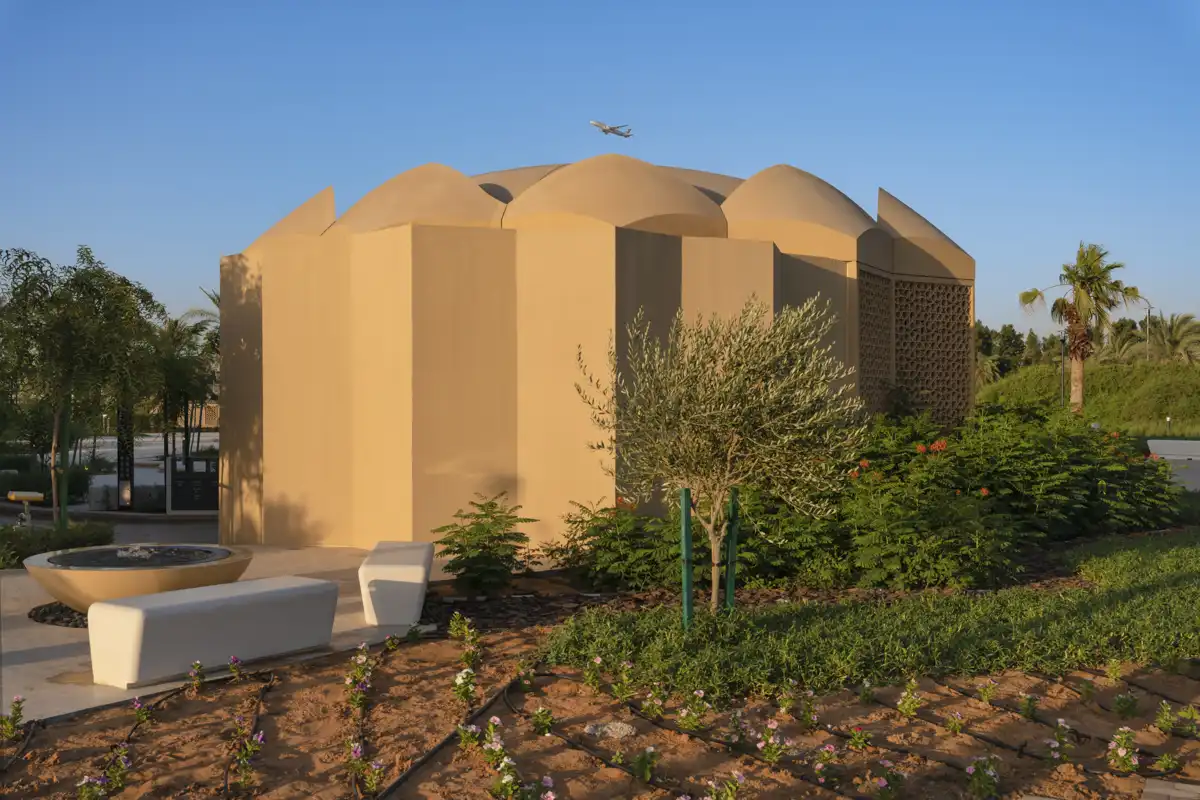
The transcending experience is accentuated with the help of aromatic plants like the Indian Cork Tree, Athel tree, Fig, and Jasmine and plants that help meditation like the common olive, pomegranate, common fig, and olibanum tree.
As visitors pass through this spiritually purifying threshold towards the prayer hall, they seem to transcend the earthly realities and set out into the mystic heavens, reaching closer to the almighty, echoing the Islamic concept of Paradise. Hence, this garden was termed Paradise Garden, directly reflecting the concept and the project’s commitment to cultural and environmental sustainability.
Form Development based on Geometric Islamic Pattern
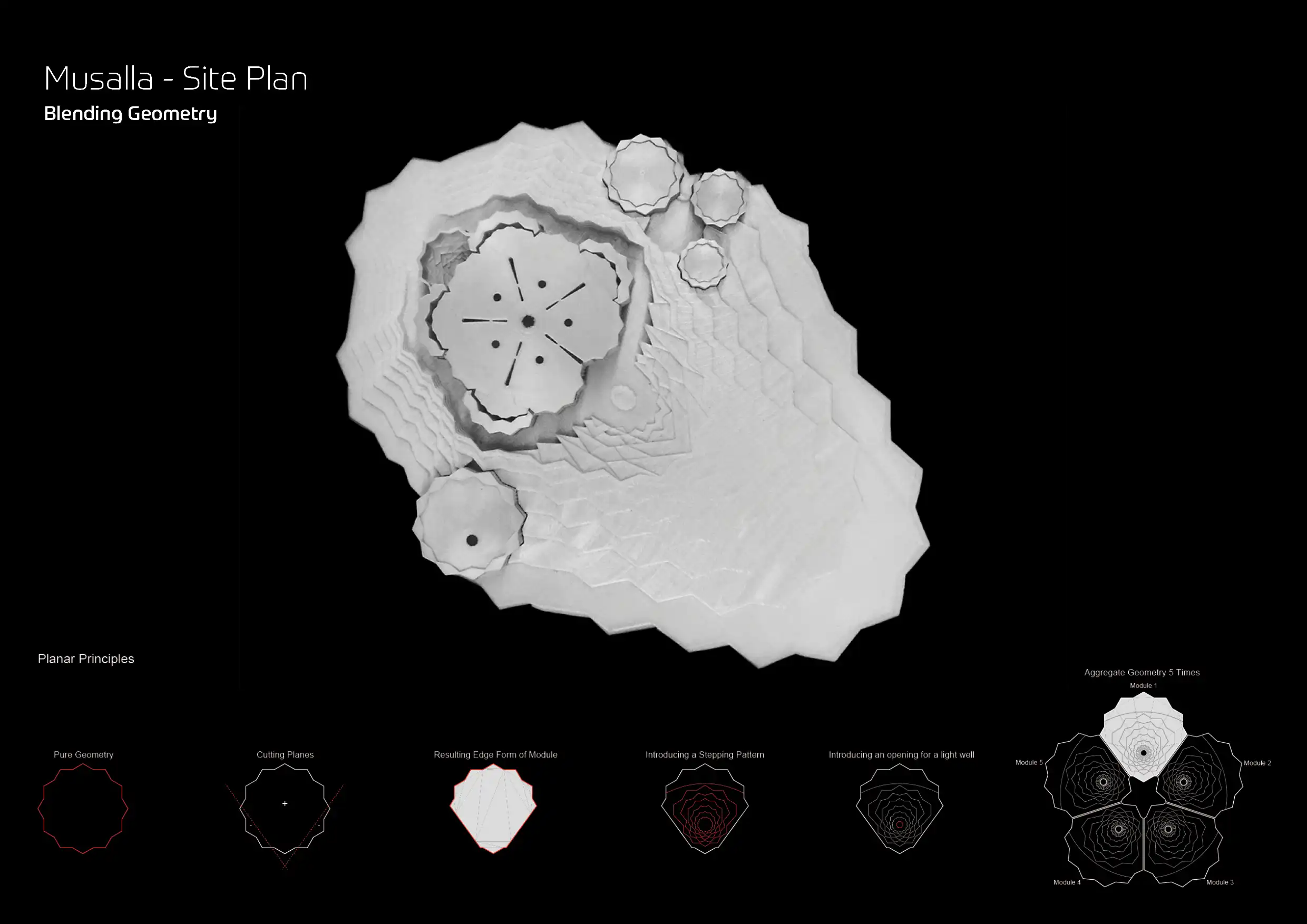
The form of the mosque, both the landscape and the actual domed prayer hall, is developed as a result of an iterative process of playing with the geometric fractal Islamic patterns, which the mosque perforated walls also feature. The designers began with a 2D geometric Islamic pattern from which they subtracted and added planar elements, then created a rippling pattern of the geometry with an off-centered opening as the skylight.
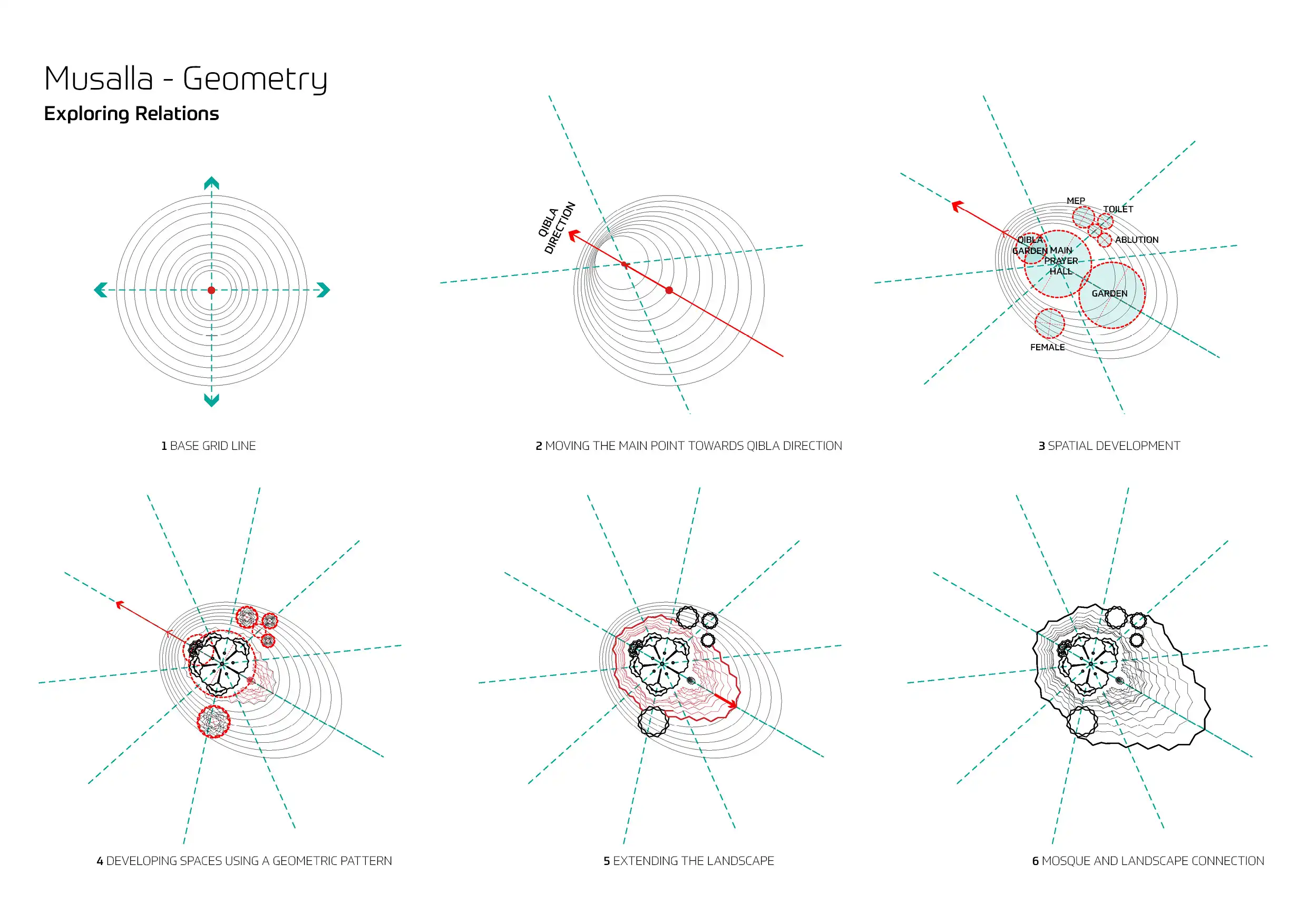
The resulting module was then repeated five times radially around a star forming the dome of the main prayer hall symbolizing the five daily prayer times. This main prayer hall’s dome plan overlapped on another geometric pattern, forming the multi-layered rippling geometric landscape design, integrating other ancillary facilities, and forming the overall plan, which was then extruded to form the mass of the mosque. The main prayer hall was located closer to Qibla, again off-centered from the landscape composition, similar to the off-centered skylights on the roof modules.
Distinguishing Spatial Components and Layout of the Estidama Mosque
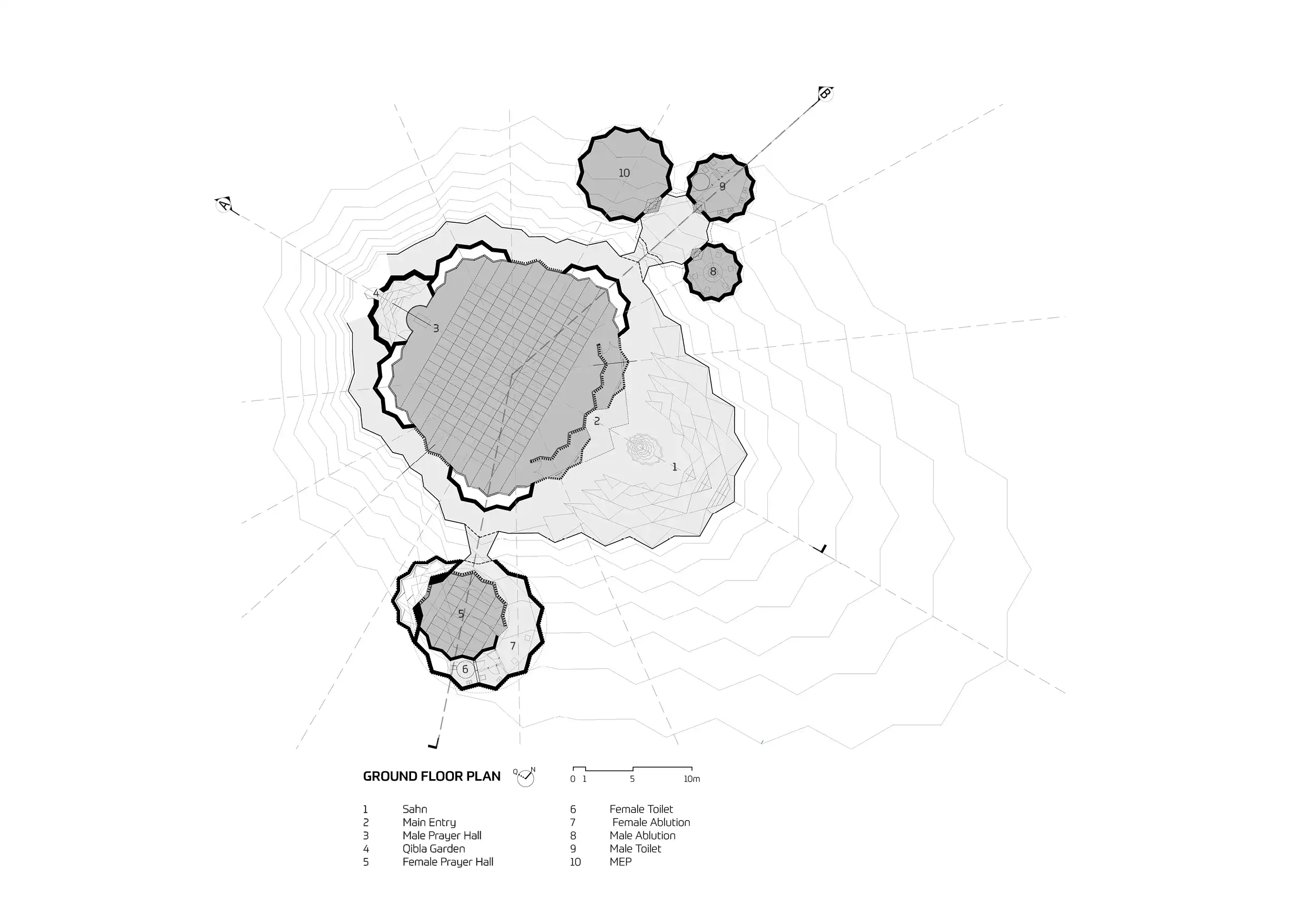
The paradise garden is significantly a distinguishing feature of this mosque, However, what sets this mosque apart from the baseline mosques is the fragmented arrangement of its spatial components. The main component of the mosque is the male prayer hall that takes center stage with its ornately designed dome roof.
The cluster of supporting spaces, including the male ablution area, male restrooms, and services zone, is located on the north, separated by the male prayer hall from the female prayer hall, ablution area, and restrooms on the south for providing adequate privacy and balance in the design.
Exploring the Structural Nuances of the Estidama Mosque Design
The depth between the highest and the lowest points of each of the five curving, intricately designed modules that make up the main prayer hall is 2.63 meters. When measuring along the radial axes from the center of the star, the longest possible dimension of the module is 8.52 meters. The thickness of the dome roof modules ranges from 0.5 meters to 1 meter as the skylight openings are compact at the outermost layer and widen up in layers on the inner surface.
The insulation supported by a corrugated steel deck and waterproofing systems is sandwiched between the structural steel beams that support the suspended ceiling panels and the outermost GRC roof panels installed on a 70mm deep substructure network.
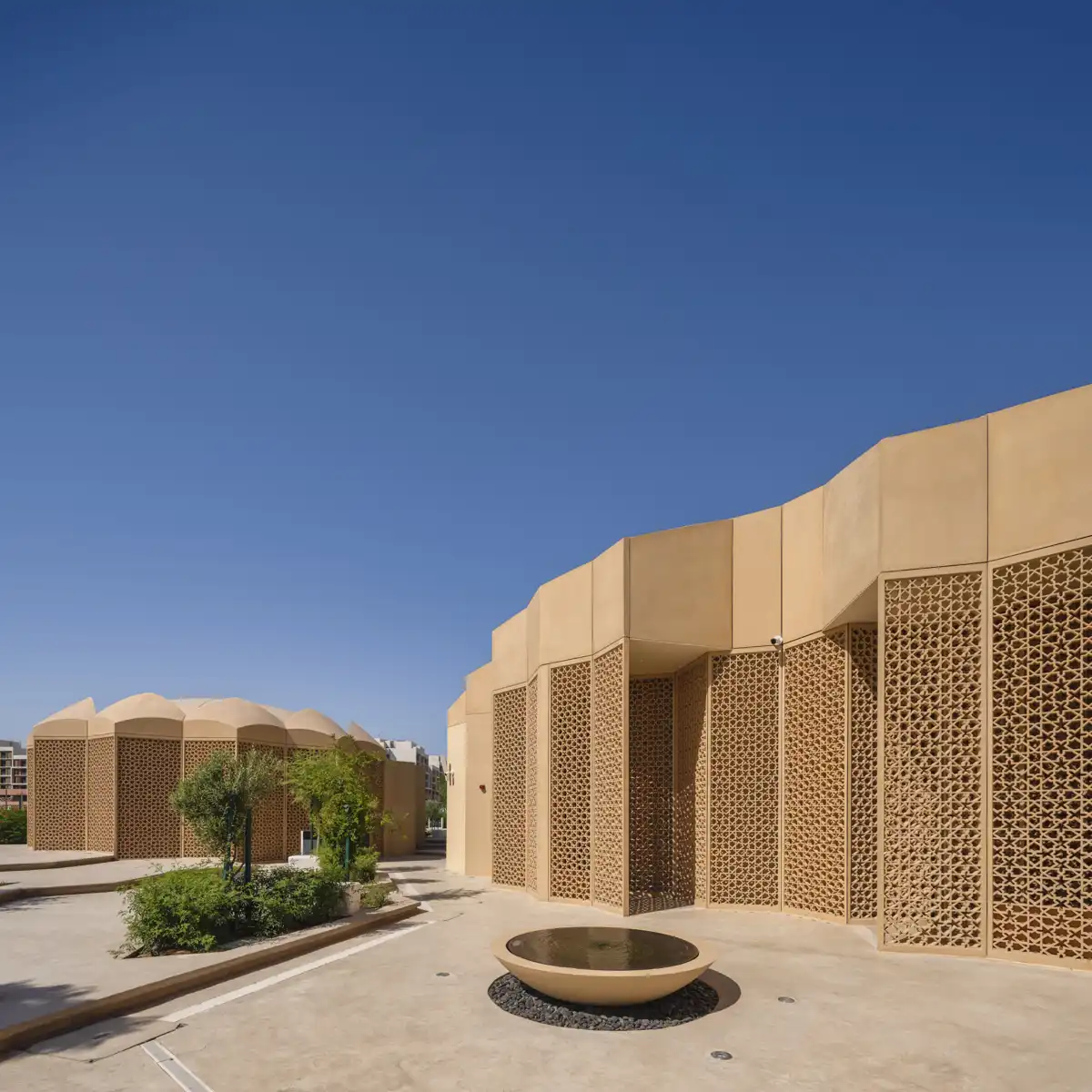
X Architects have opted for GRC for the dome panels, the perforated façade systems, the opaque walls, and other finishes owing to its lightweight, environmentally friendly nature, minimizing waste and transportation energy, and flexibility to craft intricate designs like the elaborate Islamic pattern on the walls.
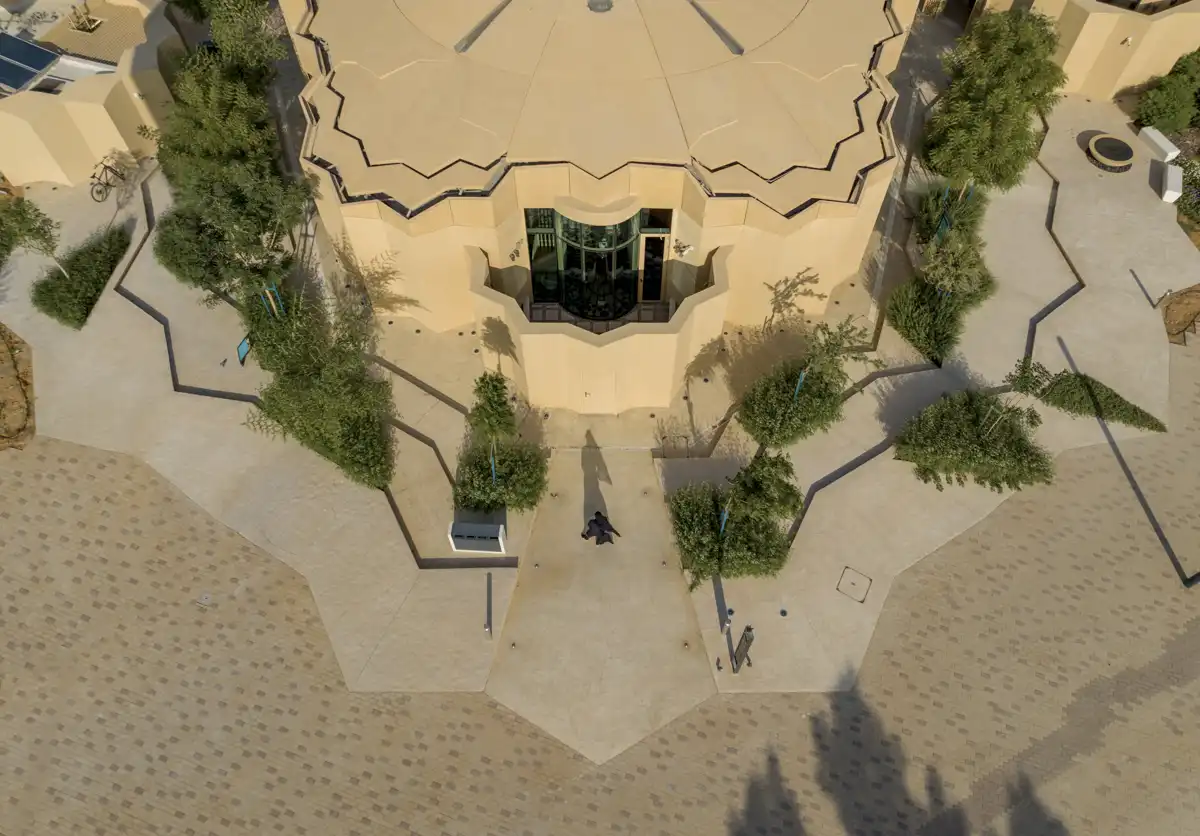
The insulation layer underneath the opaque wall panels, the micro topping wall finishes, powder-coated slim aluminum profiles holding the glass panels, and the double-glazing walls further enhance the performance of the envelope. The Mihrab wall features a unique curved glass panelization.
If you would like to design intricate structures like the Dome of the Estidama Mosque in Masdar Park learn with PAACADEMY. Attend workshops at PAACADEMY to learn from the industry’s best experts how to use advanced parametric design tools, AI in design workflows, and computational design in architecture!
Sustainable Solutions Implemented in the Estidama Mosque Design
The designers adopted passive design solutions to achieve a 50% reduction in energy consumption. For instance, an ample amount of diffused daylight enters the mosque through the articulated skylights, whilst the perforated panels featuring an intricate Islamic pattern cast an interesting interplay of refracted light and shadows, reducing the need for artificial lighting. The interplay of light and shadow was carefully studied before finalizing the design.
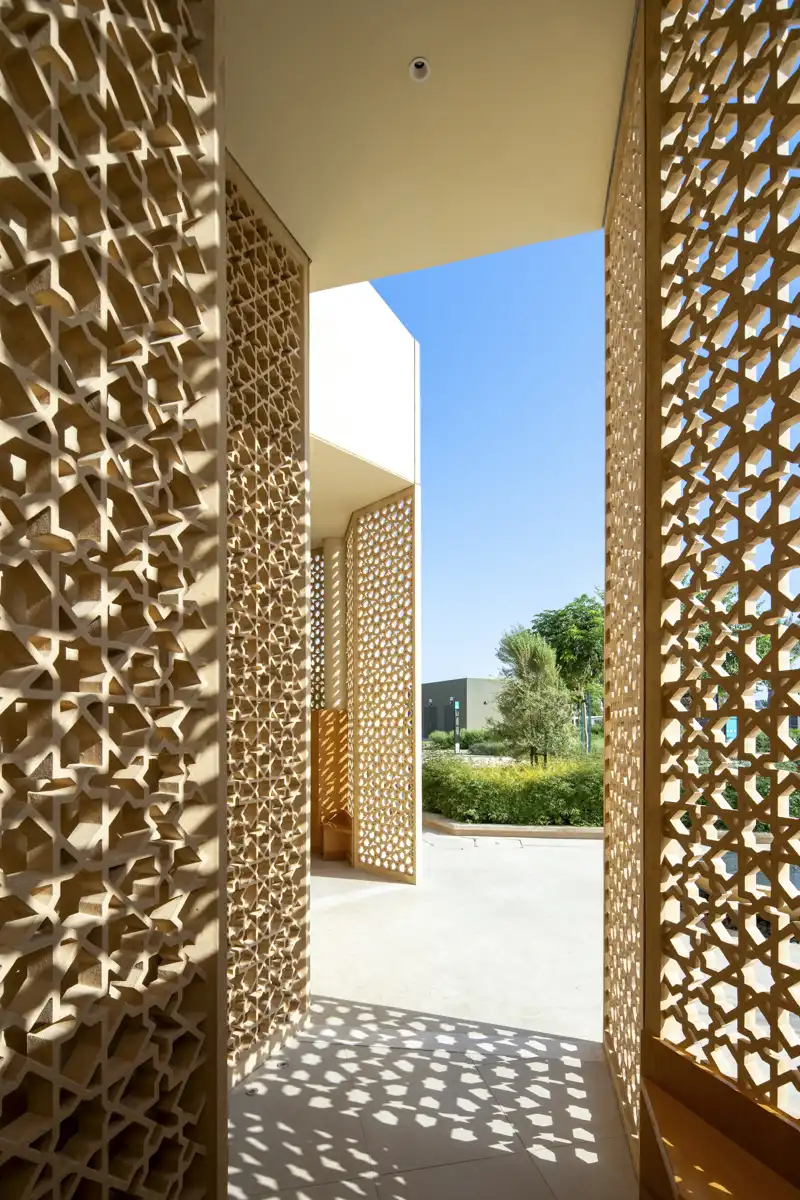
Although the region’s scorching heat demands an extensive cooling system to ensure the thermal comfort of the worshippers inside, the designers have managed to achieve a mighty 40% cooling demand reduction compared to the conventional structures. This was possible as the paradise garden, in addition to the larger Masdar Park, mitigates the urban heat island effect. In terms of the mosque design, the high ceilings and a high-performance building envelope contributed to passively enhancing the thermal comfort inside the prayer hall.
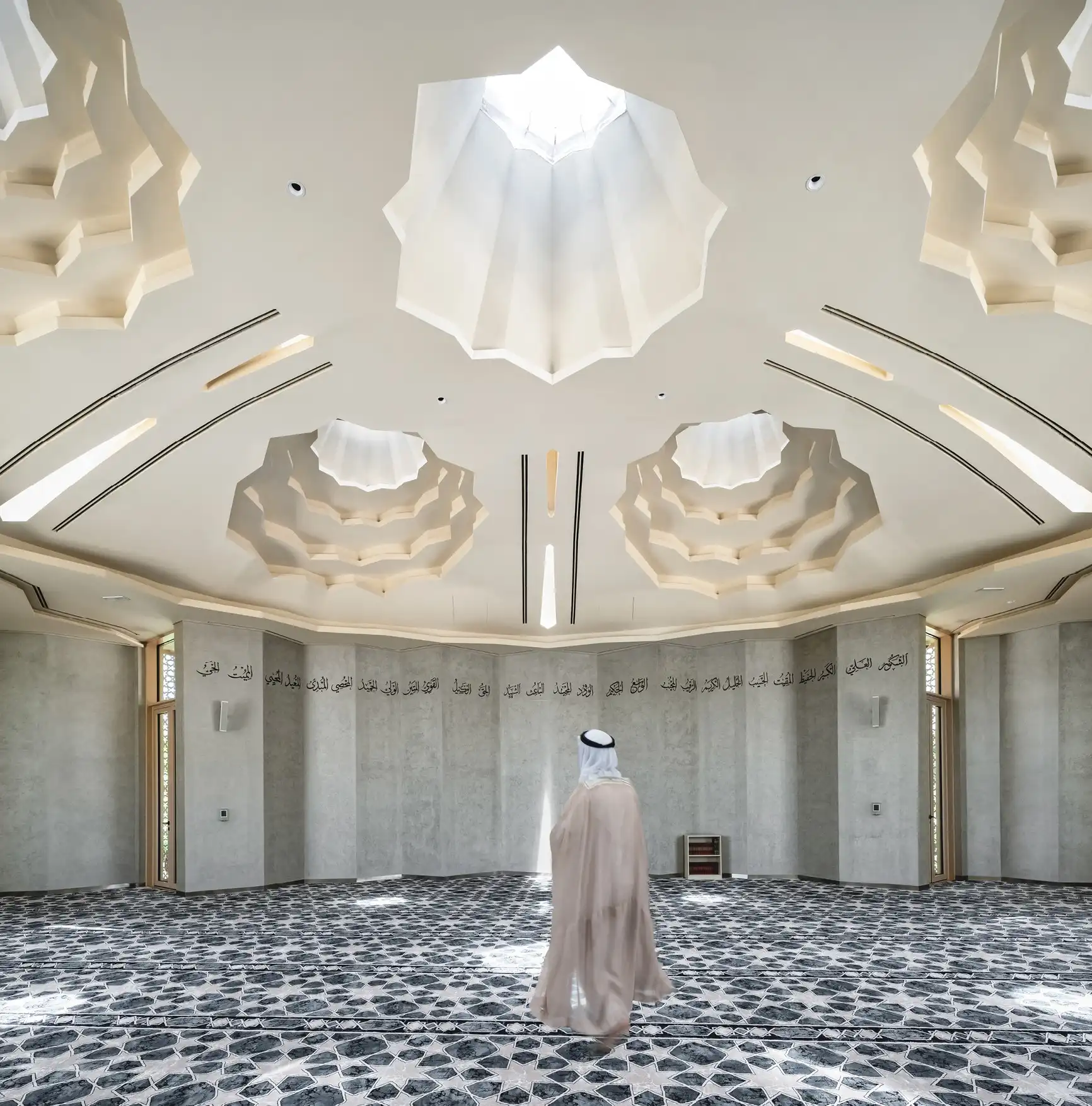
Additionally, the mosque relies on renewable solar energy from the nearby small-scale solar farm with photovoltaic panels mounted on the shading structures in the car parking space. Energy consumption is further optimized with the help of intelligent sensors that control the lighting and ventilation of the mosque based on building occupancy rates.
Although the paradise garden features extensive landscaping, it is interesting to know that water usage both for irrigation and in the interiors is reduced by 60% compared to other conventional mosques. The use of grey water for landscape irrigation has contributed to conserving approximately 48% of total water consumption.
Aligning with Masdar Park’s initiative of diverting over 93% of construction waste from landfills and using regionally sourced materials accounting for 60% of the total material employed in construction, the Estidama Mosque was also subjected to this sustainability obligation.
Owing to the designer’s sincere efforts to achieve world-class sustainability and efficiency, the project was awarded and announced as the Sustainable Construction Project of the Year at the Big 5 Global Impact Awards, in addition to acquiring LEED Platinum certification and Estidama PBRS “Pearl 3” rating.
What does the Estidama Mosque design signify?
This moderate-sized community mosque with a capacity of merely 335 worshippers signifies that in bringing about a spiritual experience, size doesn’t matter, but ambiance does! And that the desired ambiance is achieved only in spaces articulated with precision and detail. The Estidama Mosque is a testament to the fact that sustainability doesn’t hinder the creativity of the designs, in fact, it only accentuates the rich spatial experience in the projects.
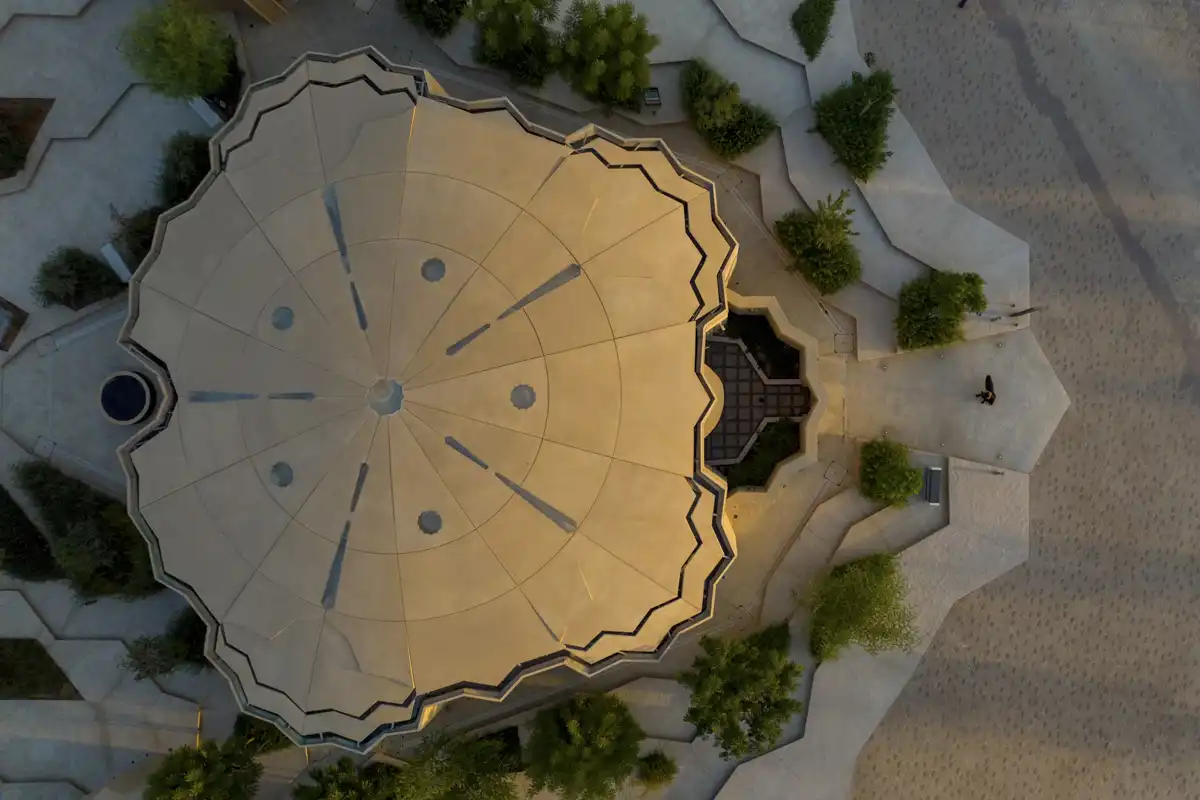
“Estidama Mosque is a powerful symbol of our commitment to our community, our faith, and responsible stewardship of the earth… We see this as so much more than a house of worship—it’s a community gathering place in the heart of our city where worshippers can look forward to a journey that is both environmentally conscious and spiritually profound,” said Engineer Mohamed Al Breiki, Masdar, City’s executive director of sustainable development.
Share this inspiring project that embodies an effective intersection of cultural and environmental sustainability, delivering a truly transcending overall spatial experience with your network of young architects and designers!
Estidama Mosque Project Details:
Project Name: Estidama Mosque
Architect: X Architects
Client: Masdar
Location: Masdar City, Abu Dhabi, UAE
Photography: DEED Studio
Drawings: X Architects




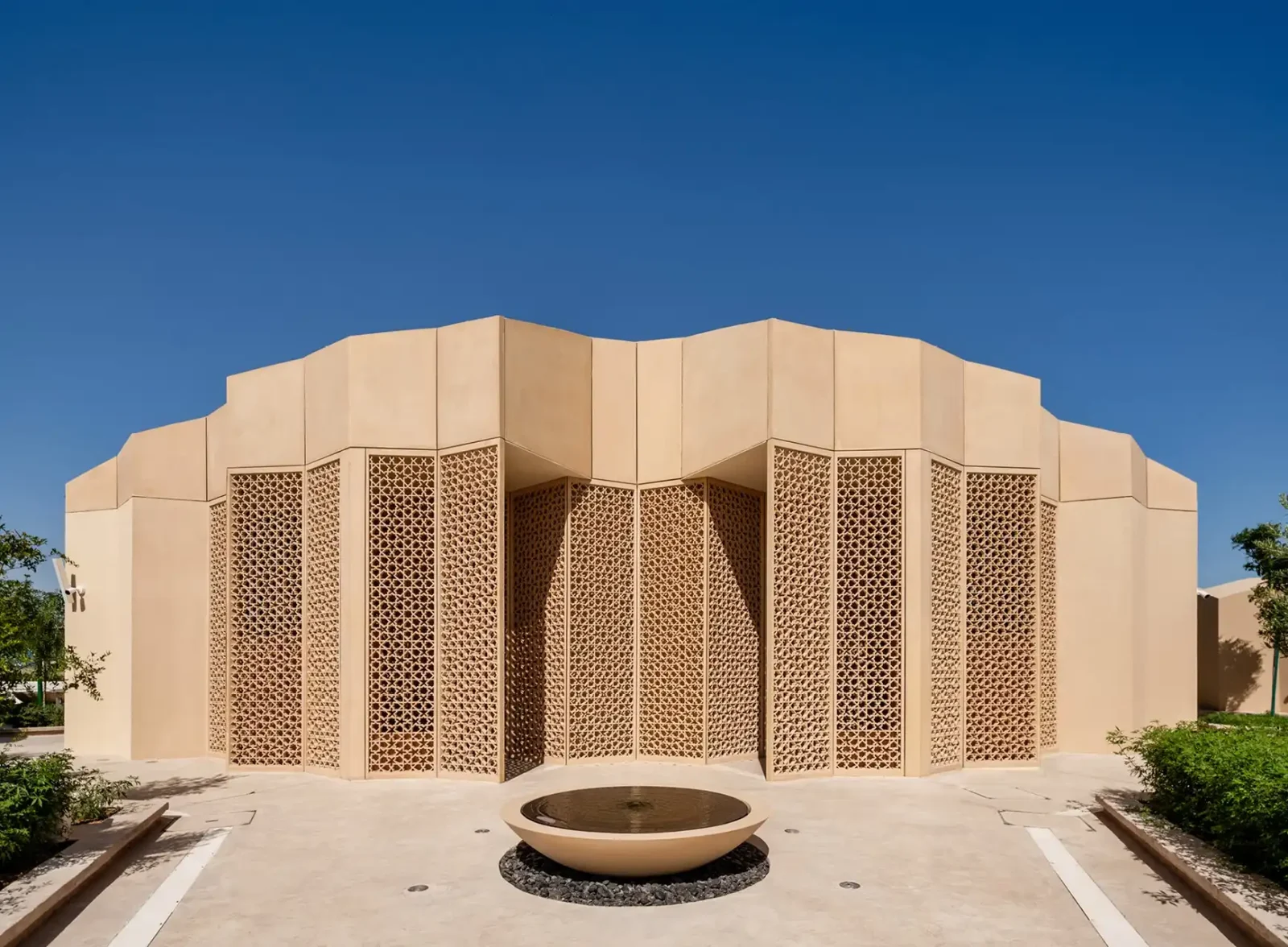













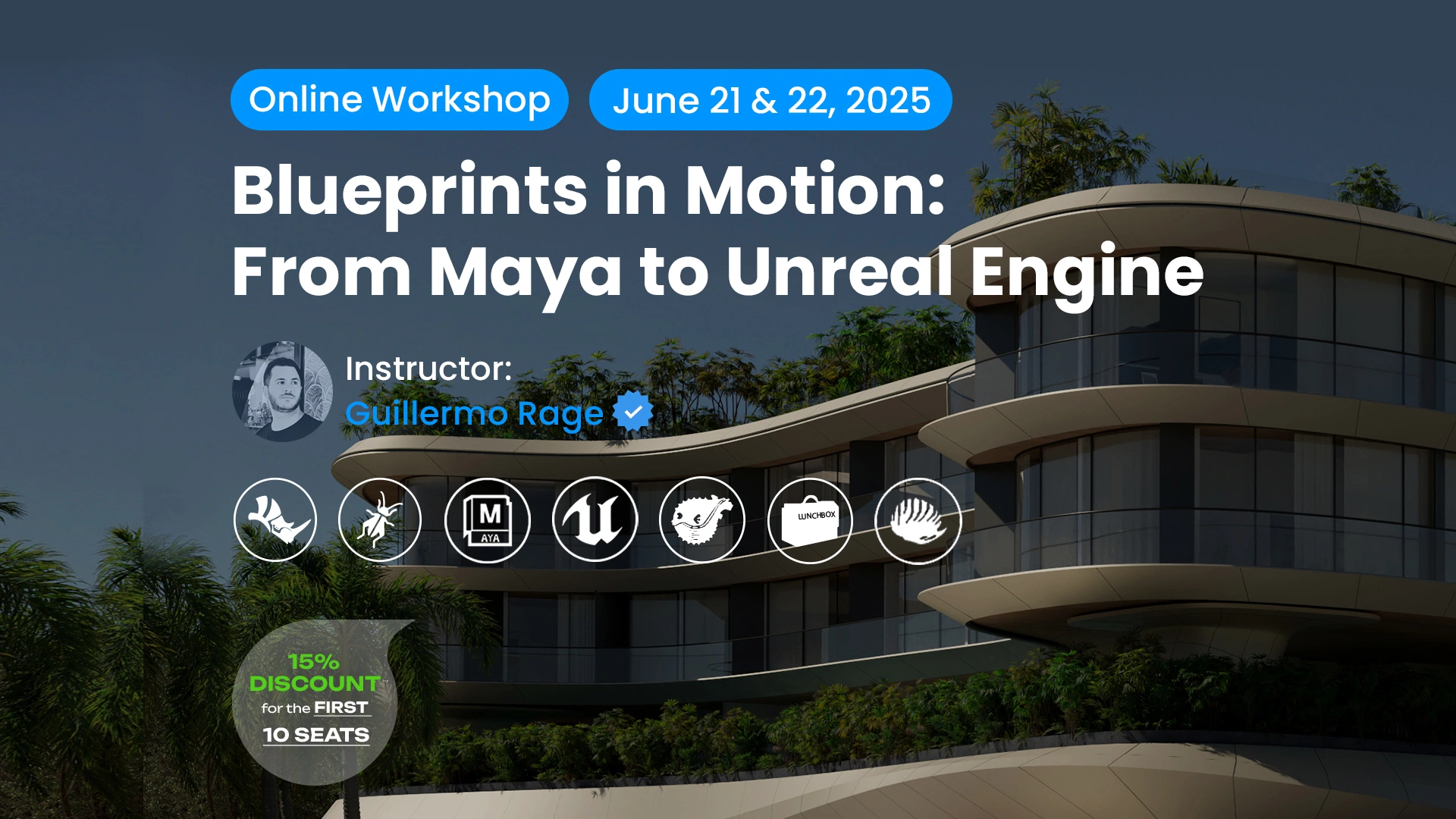












Leave a comment